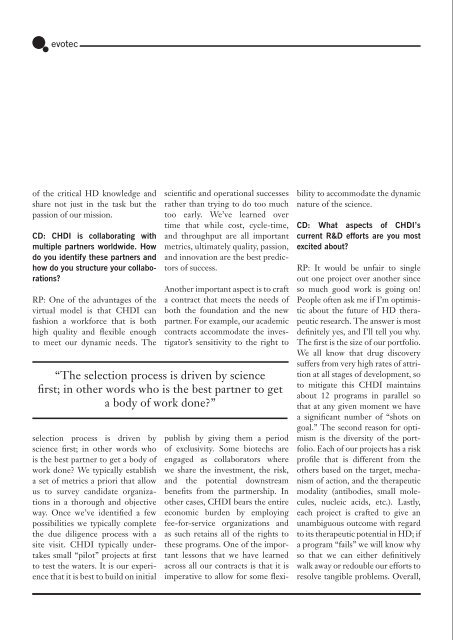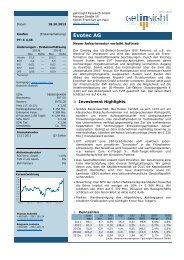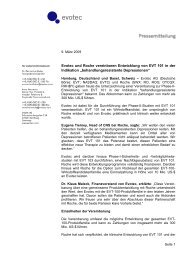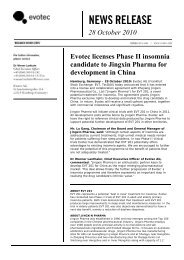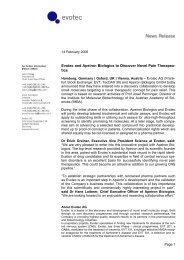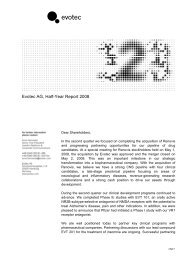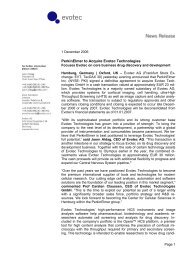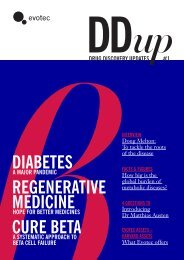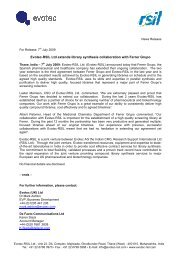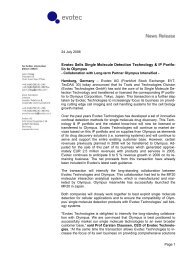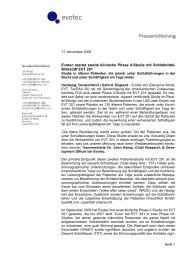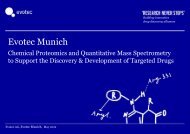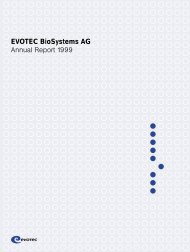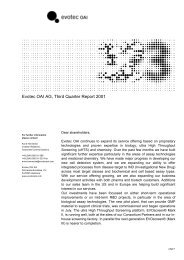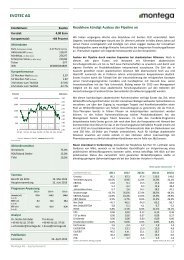Dr anDreas ebnetH - Evotec
Dr anDreas ebnetH - Evotec
Dr anDreas ebnetH - Evotec
Create successful ePaper yourself
Turn your PDF publications into a flip-book with our unique Google optimized e-Paper software.
of the critical HD knowledge and<br />
share not just in the task but the<br />
passion of our mission.<br />
cd: chdi is collaborating with<br />
multiple partners worldwide. how<br />
do you identify these partners and<br />
how do you structure your collaborations?<br />
RP: One of the advantages of the<br />
virtual model is that CHDI can<br />
fashion a workforce that is both<br />
high quality and flexible enough<br />
to meet our dynamic needs. The<br />
selection process is driven by<br />
science first; in other words who<br />
is the best partner to get a body of<br />
work done? We typically establish<br />
a set of metrics a priori that allow<br />
us to survey candidate organizations<br />
in a thorough and objective<br />
way. Once we’ve identified a few<br />
possibilities we typically complete<br />
the due diligence process with a<br />
site visit. CHDI typically undertakes<br />
small “pilot” projects at first<br />
to test the waters. It is our experience<br />
that it is best to build on initial<br />
scientific and operational successes<br />
rather than trying to do too much<br />
too early. We’ve learned over<br />
time that while cost, cycle-time,<br />
and throughput are all important<br />
metrics, ultimately quality, passion,<br />
and innovation are the best predictors<br />
of success.<br />
Another important aspect is to craft<br />
a contract that meets the needs of<br />
both the foundation and the new<br />
partner. For example, our academic<br />
contracts accommodate the investigator’s<br />
sensitivity to the right to<br />
“The selection process is driven by science<br />
first; in other words who is the best partner to get<br />
a body of work done?”<br />
publish by giving them a period<br />
of exclusivity. Some biotechs are<br />
engaged as collaborators where<br />
we share the investment, the risk,<br />
and the potential downstream<br />
benefits from the partnership. In<br />
other cases, CHDI bears the entire<br />
economic burden by employing<br />
fee-for-service organizations and<br />
as such retains all of the rights to<br />
these programs. One of the important<br />
lessons that we have learned<br />
across all our contracts is that it is<br />
imperative to allow for some flexi-<br />
bility to accommodate the dynamic<br />
nature of the science.<br />
cd: what aspects of chdi’s<br />
current r&d efforts are you most<br />
excited about?<br />
RP: It would be unfair to single<br />
out one project over another since<br />
so much good work is going on!<br />
People often ask me if I’m optimistic<br />
about the future of HD therapeutic<br />
research. The answer is most<br />
definitely yes, and I’ll tell you why.<br />
The first is the size of our portfolio.<br />
We all know that drug discovery<br />
suffers from very high rates of attrition<br />
at all stages of development, so<br />
to mitigate this CHDI maintains<br />
about 12 programs in parallel so<br />
that at any given moment we have<br />
a significant number of “shots on<br />
goal.” The second reason for optimism<br />
is the diversity of the portfolio.<br />
Each of our projects has a risk<br />
profile that is different from the<br />
others based on the target, mechanism<br />
of action, and the therapeutic<br />
modality (antibodies, small molecules,<br />
nucleic acids, etc.). Lastly,<br />
each project is crafted to give an<br />
unambiguous outcome with regard<br />
to its therapeutic potential in HD; if<br />
a program “fails” we will know why<br />
so that we can either definitively<br />
walk away or redouble our efforts to<br />
resolve tangible problems. Overall,<br />
“Each of our projects has a risk profile that is<br />
different from the others based on the target,<br />
mechanism of action, and the therapeutic modality”<br />
it is encouraging to see the maturation<br />
of the portfolio. There are now<br />
seven programs at a sufficiently<br />
mature stage of develop ment to be<br />
ready for initiation of clinical trials<br />
within the next 18–24 months.<br />
cd: what are the major challenges<br />
and how do you plan to address<br />
them?<br />
RP: There is certainly no shortage<br />
of challenges at CHDI in finding<br />
treatments for HD! We believe<br />
that, while difficult, this is ultimately<br />
a problem whose solutions<br />
will unfold over time. By way of<br />
example I can cite two things that<br />
we struggle with on an ongoing<br />
basis, one is scientific, the other<br />
more operational.<br />
Like many other late-onset,<br />
progressive, neurodegenerative<br />
diseases, there are several animal<br />
models of HD. However, it is<br />
unclear which, if any, of them are<br />
useful in predicting the human<br />
efficacy of drug candidates. A<br />
further confound is that the models<br />
which most closely resemble the<br />
human genetics develop phenotypes<br />
very slowly, resulting in<br />
long and costly preclinical animal<br />
studies. CHDI has abandoned the<br />
one-size-fits-all philosophy as we<br />
simply no longer believe that it is<br />
possible to recapitulate the whole<br />
of human pathosphysiology in any<br />
single animal model. Instead, we<br />
have now adopted a more customized<br />
approach where the species,<br />
perturbation, and outcomes for our<br />
animal studies are tailored to the<br />
individual needs of each program.<br />
This is accomplished by having a<br />
firm mechanistic hypothesis that<br />
allows us to design the appropriate<br />
pharmacokinetic / pharmacodynamic<br />
assays that will tell us if<br />
a compound is, at the very least,<br />
acutely able to exert its biochemical<br />
effects. Once that has been established,<br />
it is a lot easier to justify<br />
the time and expense required<br />
to achieve the more macroscopic<br />
phenotypic benefits, like improvement<br />
in survival.<br />
Together with its many partners,<br />
CHDI has generated a huge volume<br />
of scientific data. Over the past<br />
eight years, we have probably erred<br />
on the side of “doing” rather than<br />
“telling.” As a consequence, there<br />
is a huge backlog of information<br />
that needs to be communicated to<br />
the broader community. With a<br />
dedicated Scientific Communications<br />
Director onboard and new<br />
informatics hires on the way, we<br />
hope to do a better job of publishing<br />
“Models which most closely resemble the human<br />
genetics develop phenotypes very slowly, resulting<br />
in long and costly preclinical animal studies”<br />
9<br />
and sharing what we have learned<br />
to reduce redundancy and increase<br />
the chances that a new investigator<br />
can fully leverage the existing<br />
knowledge base. Articles like this<br />
are a good start and I think you’ll<br />
be seeing much more in the way of<br />
news flow from CHDI using different<br />
media platforms.


